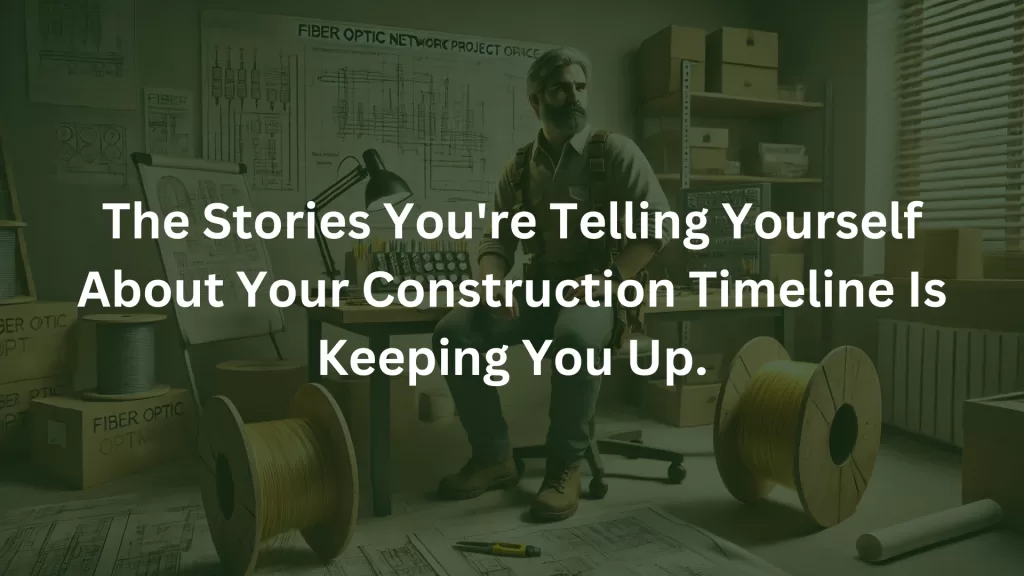
Awaken again, it’s 3 AM, and you’re staring at the ceiling. You got a board meeting today, and you are thinking through how you are going to explain why your program is 4 months behind schedule and over 30% over budget. “Supply chain issues,” you’ll say. “Permitting delays.” “Labor shortages.” All true, but you know there’s more to it.
I’ve been in that room. I’ve given those explanations. And after two decades in fiber deployment, I can tell you the real truth: we’re all lying to ourselves about construction timelines, and it’s costing us millions.
The Comfortable Lies We Tell Ourselves
“We’ll make up the time in Phase 2.”
“The contractors assured us they can double their crews.”
“The weather will cooperate eventually.”
“Our timeline has plenty of buffer built in.”
Sound familiar? These aren’t just optimistic projections , they’re comfort food for worried executives. But like most comfort food, they’re not good for you.
Last year, I watched a mid-sized electric cooperative in the Midwest learn this the hard way. They planned an ambitious 18-month build to serve 12,000 homes. Their timeline was based on perfect conditions: immediate permitting, ideal weather, and seamless contractor coordination. Twenty-eight months and several million dollars in cost overruns later, they’re still not done. The board is furious, subscribers are jumping ship to Starlink, and the CEO is polishing his resume.
The Real Cost of Timeline Delusion
Here’s what makes construction timeline denial so insidious: it’s not just about delayed revenue. Every month of delay creates a cascade of hidden costs that rarely make it into the initial projections:
- Contractor retention costs surge as crews sit idle waiting for materials or permits
- Material prices inflate beyond your locked-in rates
- Subscribers abandon deposits and pre-registrations
- Marketing campaigns misfire when you can’t deliver on promised availability dates
- Staff morale plummets as customer complaints flood in
- Your competitors use your delays in their marketing
Most companies are still using traditional project management approaches that failed when fiber was simple and fiber isn’t simple anymore. They’re using Excel sheets to manage complex supply chains, relying on contractor promises without verification systems, and treating permits as an afterthought instead of a critical path item.
Why Traditional Approaches Keep Failing
Think of fiber deployment like conducting an orchestra. Every section, construction, permitting, materials, marketing needs to play their part at exactly the right time. Traditional project management is like trying to conduct that orchestra through a series of separate phone calls, hoping everyone stays in sync.
The numbers don’t lie:
- 82% of fiber projects exceed their original timeline by at least 25%
- The average material delivery delay adds 3.2 months to project completion
- Permit approval times have increased 47% in the last three years
- Labor costs escalate an average of 12% for every three months of delay
Your board sees the monthly reports but misses the compound effect. Your subscribers don’t care about your challenges, they just want their internet. And your team? They’re caught in the middle, trying to make chicken salad out of chicken feathers.
A Better Way Forward
Here’s where I could tell you to just “plan better” or “add more buffer time.” But that’s like telling someone who’s drowning to just swim harder. Instead, let’s talk about how successful builds actually happen.
Imagine your fiber build as a cross-country road trip. Traditional planning is like checking the weather at your starting point and assuming it’ll be the same all the way across the country. Smart planning is like having a network of local weather stations giving you real-time updates along your entire route.
This is where Central State Utility’s approach makes a fundamental difference. We don’t just plan for best-case scenarios – we actively map out and prepare for the obstacles we know you’ll face. Our project management system was built specifically for fiber deployment, integrating real-time data from every aspect of your build:
- Material tracking that alerts you to delays before they impact construction
- Permit management that parallels multiple approval paths
- Crew efficiency monitoring that catches productivity issues early
- Weather impact modeling that helps adjust schedules proactively
One of our recent partners, a municipal utility in the Southeast, came to us after burning through six months of timeline buffer in their first two months of construction. Within 60 days of implementing our system, they were back on schedule. More importantly, they had clear visibility into upcoming challenges and actual, achievable solutions.
Your Legacy Moment
Here’s the reality: fiber builds are career-defining projects. Done right, they transform communities and cement your leadership. Done wrong, they can unravel years of credibility in months.
The choice isn’t between optimism and pessimism – it’s between hope and strategy. Hope is thinking your timeline will work out despite evidence to the contrary. Strategy is having systems in place to identify and solve problems before they derail your project.
You don’t have to wake up at 3 AM wondering if you’re being lied to by your contractors or if your materials will show up on time. You don’t have to face your board with another creative explanation for delays.
Ask yourself: In two years, do you want to be known as the leader who delivered on their promises, or the one who had the best excuses for why they couldn’t?
The next step is simple: Schedule a reality-check session with our team. No sales pitch, no pressure – just an honest assessment of your current timeline and the specific risks you’re facing. Because the only thing more expensive than doing it right is doing it over.
Remember, the best time to fix your timeline was when you started planning. The second best time is now.
What story do you want your fiber build to tell?
